330 Search Results for communication boards
April 13, 2012
by Carole Zangari -
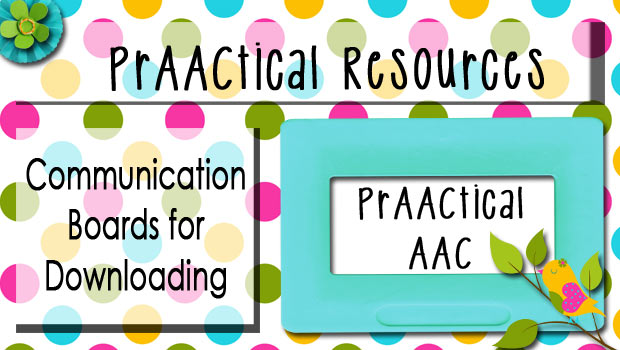
If you’re like us, you’re always happy to find sites where AAC materials can be downloaded, preferably for free. Bookmark those sites because they are huge time savers. If you’re trying to build your own professional resource library, check out this site for boards designed for people to communicate about healthcare, employment, sexuality, transportation, and other topics. Several of the communication boards are also available in Spanish (like the example shown here) and Haitian Creole. Kudos to the fine work done by the AAC-RERC and the Temple University Institute on Disabilities. –
March 22, 2023
by Carole Zangari -
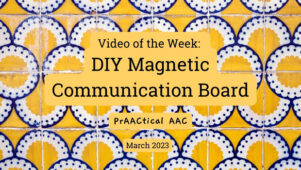
Communication boards come in all sizes and are made from a range of materials. In today’s featured video Carrie Clark of Speech and Language Kids shares her ideas about using a cookie sheet to create a communication board. Direct Link to Video – https://www.youtube.com/watch?v=mnyv8h6J4rc&ab_channel=CarrieClark%2CSLPSolution
July 12, 2021
by Carole Zangari -
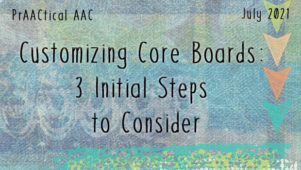
Core boards have gained popularity as an on-ramp to AAC in classrooms and therapy centers, and can be a valuable way to bolster implementation in those settings. AAC users need and deserve to use communication tools that reflect their individuality, though, so these are generally seen as a stepping stone to an approach that uses assessment data to make AT decisions. In the meantime, how can we ensure that the core boards we use are functional for the complex AAC learners we serve? Here are three areas to consider addressing. Vision: If the AAC learner has visual difficulties, it’s important to determine what changes need to be made so that they can see and use the core board. In collaboration with a vision specialist who knows the AAC learner’s needs and abilities, the team should consider things like: The size of the individual symbols and words, Optimizing color and contrast, ... [Read More...]
August 5, 2019
by Carole Zangari -
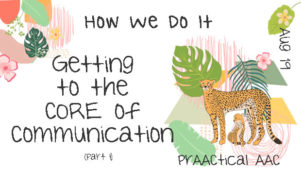
Looking to create a sustainable AAC program in your school? Today, we learn about the way one school district in Illinois created a core vocabulary initiative that has been up and running for almost a decade. Kelly Key, the Assistive Technology (AT) Coordinator for Barrington School District 220 serves as our tour guide. Kelly is passionate about giving students a voice through core vocabulary and empowering others to support students. She has been in the field for over 22 years as a special education teacher, an administrator, and AT Coordinator. Kelly presents at local, state, and national conferences and colleges on various AT topics including core vocabulary and AAC implementation. ::::::::::::::::::::::::::::::::::::::::::::::::::::::::::::::::::::::::::::::::::::::: How We Do It: Getting to the CORE of Communication (Part 1) Rolling Out a Core Vocabulary Initiative- How this District has been going strong for a decade! The Importance of Using Core Vocabulary As we all know, individuals with complex... [Read More...]
August 1, 2019
by Carole Zangari -
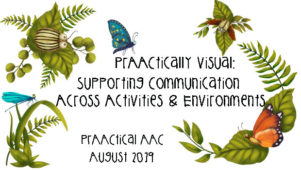
We’re thrilled to continue our series on visual supports, guest authored by AAC SLP Tabi Jones-Wohleber. Tabi has been an AAC service provider for many years and graciously offered to share some of her resources with our PrAACtical AAC readers. In today’s post, Tabi focuses on supplemental AAC supports that promote communication throughout the day. Be sure to download the files for the templates and resources she is sharing. In case you missed them, here are the links to the previous posts in this series. Part 1: Visual & Environmental Countdown Part 2: Organizing Time & Tasks Part 3: Self-Regulation & Understanding Expectations :::::::::::::::::::::::::::::::::::::::::::::::::::::::::::::::::::::::::::::::::::::::::::::::::::::::::::::::::::::::::::::::::::::::::::::::::::::::::::::::::::: PrAACtically Visual: Visual Supports for Communication Across Activities and Environments As the near entirety of this site is dedicated to resources for AAC implementation and access for individuals with complex communication needs, I’m not going to attempt to summarize here, as I have with the other... [Read More...]
January 14, 2019
by Carole Zangari -
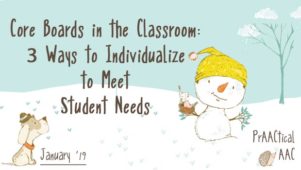
In the US, poster-sized core boards are displayed in a growing number of special education classrooms. In some cases, the displays match the AAC systems that were selected for the students following a comprehensive AAC evaluation. In others, they are more of a compromise measure which are used in order to get communication teaching started while the AAC evaluation process is still in progress. Either way, we eventually want to move from a one-size-fits-all approach to one where there are more individualized communication tools. Here are some of the key areas to consider in that process. Vocabulary: While there are many benefits of modeling and eliciting a starter set of core vocabulary throughout the day, there is no denying that specific words are very powerful. What other words (fringe or core), would make a difference in his/her/their learning trajectory? For some, we may consider adding things like the names of... [Read More...]
June 11, 2018
by Carole Zangari -
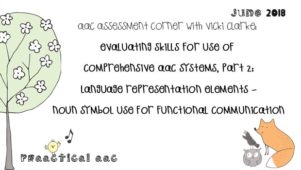
Vicki Clarke, CEO of Dynamic Therapy Associates and Director of DTA Schools, is back with another wonderful edition of AAC Assessment Corner. In addition to their clinic, Vicki and her team support school districts in AAC evaluation, equipment procurement, and implementation for individual students in the academic environment. DTA Schools also supports district-wide AAC implementation through the Classroom Communication Goals Project, training, and supporting all team members in classroom AAC implementation. In today’s post, Vicki shares her thoughts on how we can look at the use of AAC symbols for nouns as part of our evaluations for comprehensive AAC systems. You can view her previous contributions to the AAC Assessment Corner here. :::::::::::::::::::::::::::::::::::::::::::::::::::::::::::::::::::::::: Evaluating Skills For Use of Comprehensive AAC Systems, Part 2: Language Representation Elements – Noun Symbol Use for Functional Communication It was a crazy, busy month full of evaluations, trainings, and report writing. I’ve spent a lot of time with... [Read More...]
October 5, 2017
by Carole Zangari -
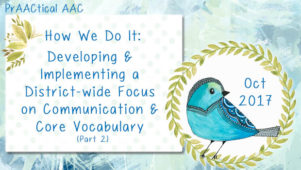
We’re back with Georgia-based SLP Jennifer Ro to hear more about a district-wide rollout of AAC in which they established (and have maintained) a core vocabulary focus. Jennifer is currently the lead AAC-SLP on Forsyth County Schools’ Assistive Technology Team where she provides AAC implementation support and trainings for staff and families and conducts individual AAC student consults. You can see Part 1 of the post here. Today, Jennifer shares some of what they learned in the process of creating AAC materials for the classroom and supporting the implementation of those materials. Let’s continue with more ‘lessons learned’ from this AAC experience. ================= How We Do It: Developing, Implementing a District-wide Focus on Communication & Core Vocabulary (Part 2) How we did it. And keep doing it … 😉 Create and develop supplemental materials that can be utilized universally and then modified, if needed, for individual student or teacher... [Read More...]
April 18, 2016
by Carole Zangari -
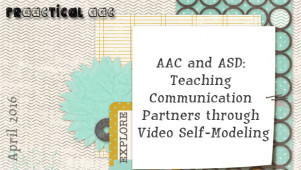
It is an honor to have Dr. Joanne Cafiero, an AAC consultant for individuals with complex communication needs and Autism Spectrum Disorders, as a guest contributor for today’s post. Dr. Cafiero is the author of Meaningful Exchanges for People with Autism an Introduction to AAC (2005). She is a consulting editor for Focus on Autism and Other Developmental Disabilities and has guest edited several of ASHA’s Perspectives in AAC. She was a member of the National Academy of Sciences Committee on Educational Interventions for Children with Autism (2001) and is currently working on an update on AAC and Autism for the Academy. In this post, she shares some of her work on video self-modeling. ::::::::::::::::::::::::::::::::::::::::::::::::: Growing research and first-person reports are illuminating the unique sensory and motor differences experienced by people on the Autism Spectrum. This new information has a huge impact on the AAC practitioner. Motor planning differences in ASD can... [Read More...]
December 1, 2015
by Carole Zangari -
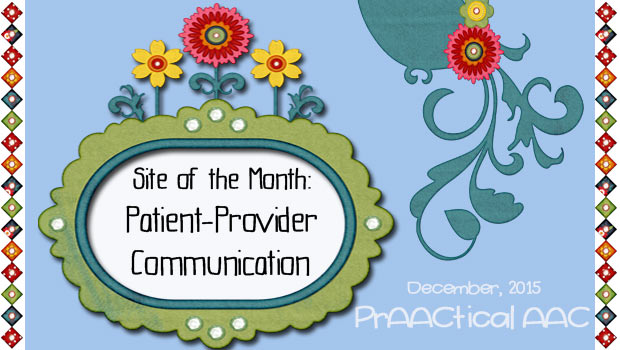
Doctor appointments, feeding tube placement, ear check, blood pressure, suctioning, IV medication, oxygen through a nasal cannula, trach changes, blood work No matter what the age or type of disability, almost all AAC learners face the challenge of communicating effectively during encounters with healthcare professionals. People with AAC needs are among those who are considered to be communication vulnerable and do best when there are planned supports in place. The Patient-Provider Communication (PPC) website hosts projects and resources to improve interactions between people with communication challenges and their healthcare providers. It is also the online home to a group of professionals across the globe who share information and collaborate to improve communication at physician offices, clinics, emergency rooms, acute care and rehabilitation hospitals, intensive care units, home health services, and hospice facilities. It is funded by the Central Coast Children’s Foundation and directed by AAC pioneer Dr. Sarah Blackstone and... [Read More...]









